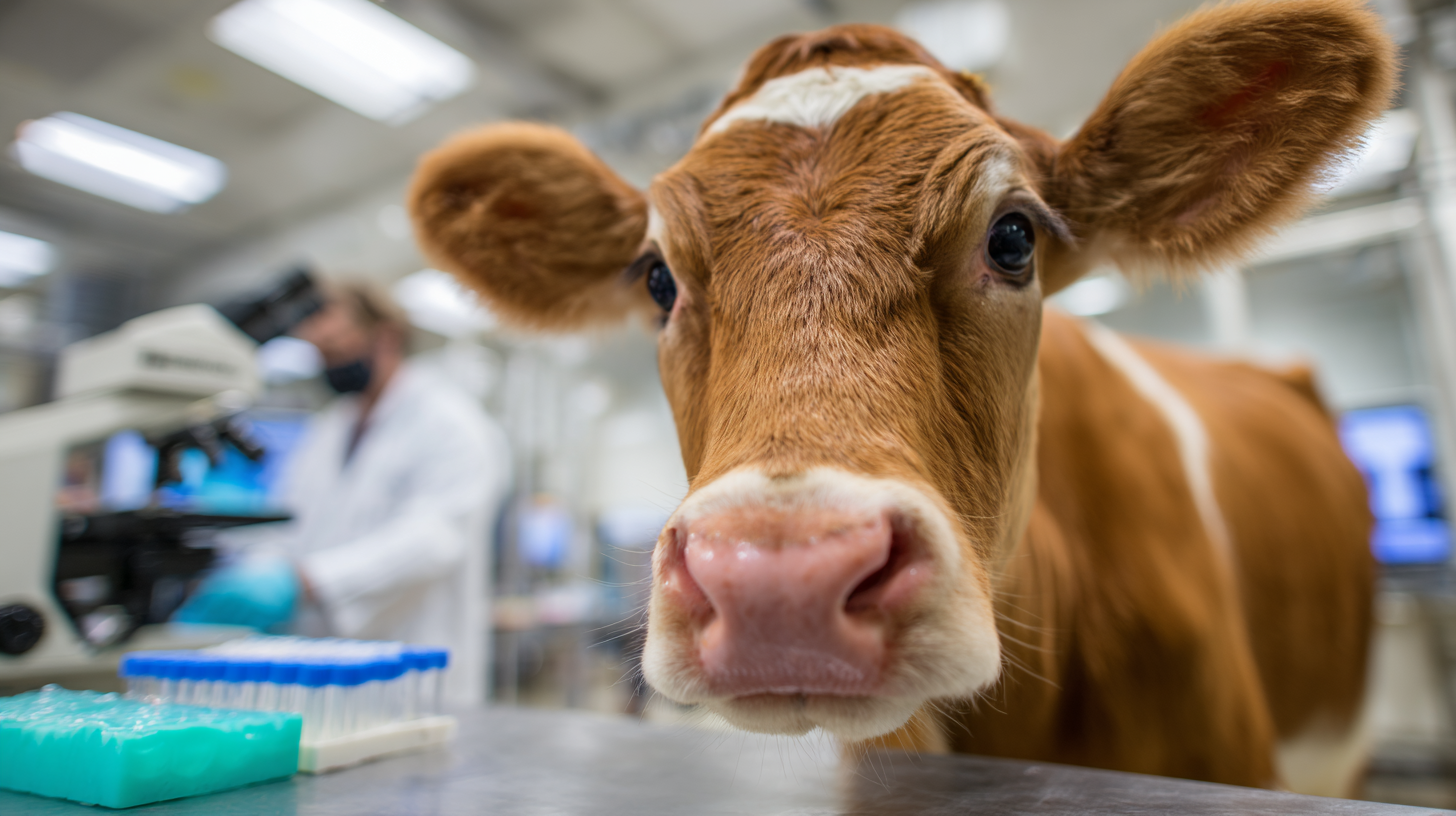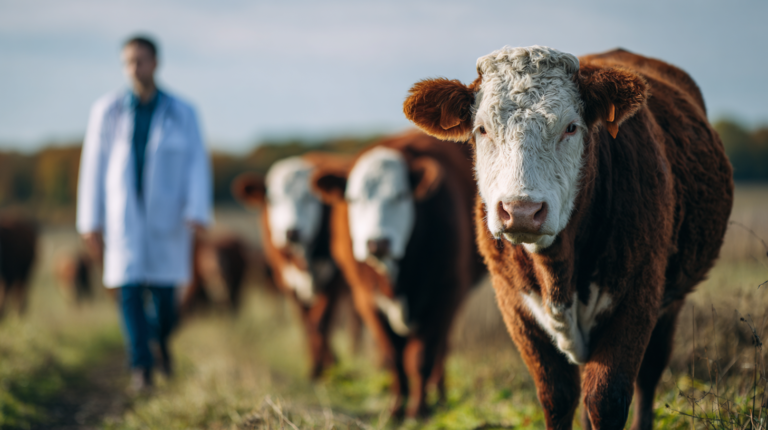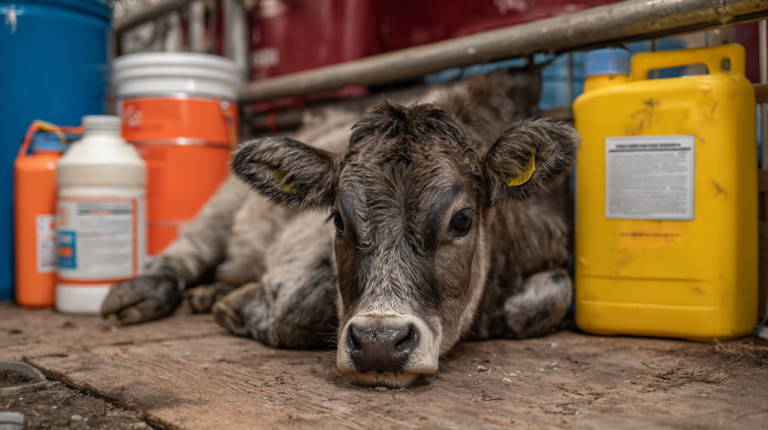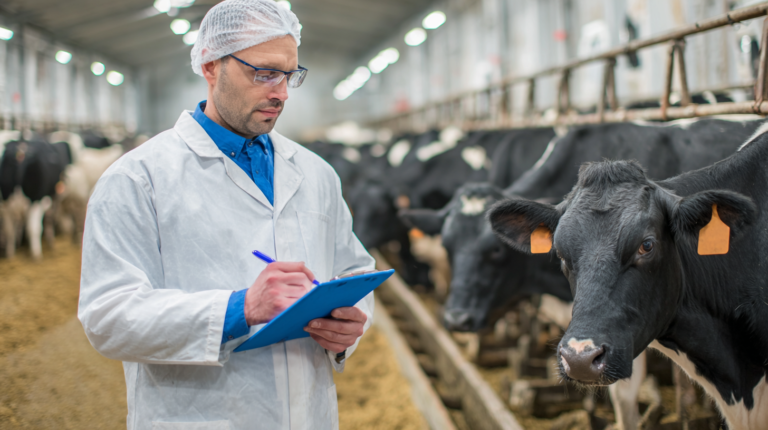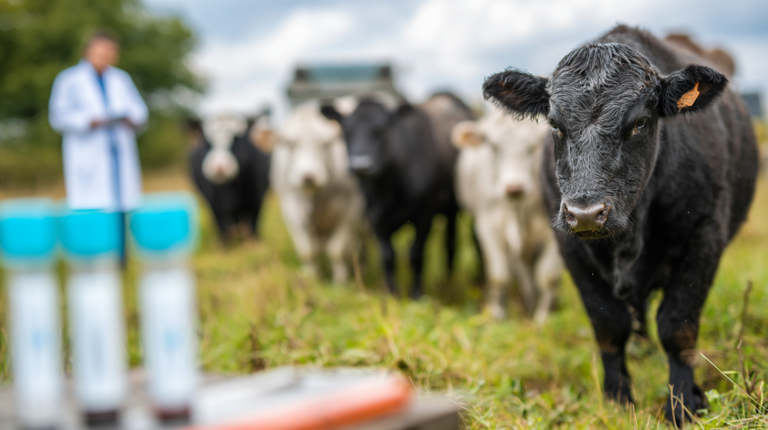Discover 8 critical facts about Johne’s Disease in Cows, including symptoms, prevention strategies, and economic impact. Expert veterinary insights for livestock health management.
Table of Contents
When dairy farmers and cattle ranchers discuss their biggest health concerns, Johne’s Disease in Cows consistently ranks among the most devastating conditions affecting livestock worldwide. This chronic bacterial infection, caused by Mycobacterium avium subspecies paratuberculosis (MAP), silently infiltrates herds and causes irreversible damage to the intestinal tract of infected animals. While many pet owners may not directly encounter this disease, understanding its impact on cattle health, food safety, and potential zoonotic concerns makes this knowledge invaluable for anyone involved in animal care or agriculture.
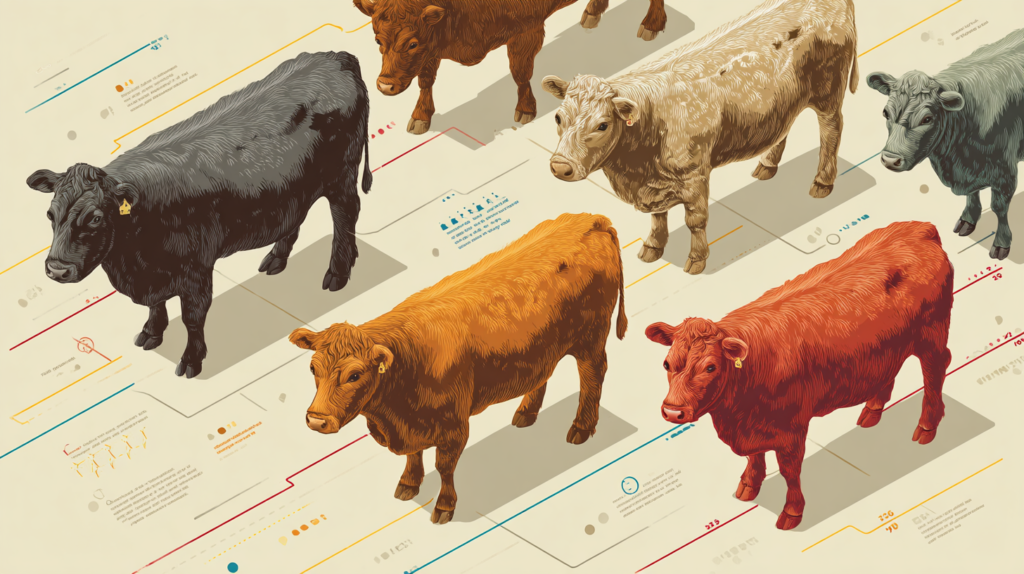
Johne’s Disease in Cows represents one of the most economically significant cattle diseases globally, with estimated annual losses exceeding $1.5 billion in the United States alone. The insidious nature of this condition—characterized by a lengthy incubation period that can span several years—makes early detection and prevention particularly challenging. Yet, armed with the right knowledge and preventive strategies, farmers and animal health professionals can significantly reduce its impact on their operations.
This comprehensive guide will explore eight critical facts about Johne’s Disease in Cows that every livestock owner, veterinarian, and animal enthusiast should understand. From recognizing early warning signs to implementing effective prevention protocols, we’ll delve into the latest research, expert insights, and practical management strategies that can help protect cattle herds from this persistent threat.
Johne’s Disease Clinical Signs & Disease Progression in Cows
| Disease Stage | Duration | Clinical Signs | Diagnostic Accuracy | Management Priority |
|---|---|---|---|---|
| Silent/Subclinical | 2-10 years | No visible symptoms, bacteria shedding may begin | Low (25-40%) | Prevention & monitoring |
| Early Clinical | 6-12 months | Mild diarrhea, gradual weight loss, decreased milk production | Moderate (50-70%) | Isolation & testing |
| Advanced Clinical | 3-6 months | Chronic diarrhea, severe weight loss, bottle jaw, rough coat | High (80-95%) | Culling recommended |
| Terminal | 1-3 months | Severe emaciation, profuse diarrhea, recumbency | Very High (95%+) | Immediate removal |
| Asymptomatic Shedder | Variable | No clinical signs but high bacterial shedding | Variable (40-80%) | Environmental testing |
Understanding the Fundamentals of Johne’s Disease
Johne’s Disease in Cows, also known as paratuberculosis, is a chronic granulomatous enteritis that primarily affects the small intestine and associated lymph nodes. The causative agent, Mycobacterium avium subspecies paratuberculosis, belongs to the same family as the bacteria responsible for tuberculosis and leprosy, sharing similar characteristics in terms of slow growth and resistance to environmental stresses.
The disease process begins when young calves ingest the MAP bacteria through contaminated milk, water, or environmental sources. Once inside the animal, the bacteria establish themselves in the intestinal wall, triggering a slow but progressive inflammatory response. What makes this condition particularly insidious is its extremely long incubation period—infected animals may not show clinical signs for two to five years, during which time they can shed bacteria and infect other animals.
Dr. Sarah Mitchell, a veterinary epidemiologist at the University of Wisconsin-Madison, explains, “The challenge with Johne’s Disease lies in its ability to remain dormant for years while the animal appears perfectly healthy. By the time clinical signs manifest, the intestinal damage is often irreversible, and the animal has likely been shedding bacteria for months or even years.”
The economic impact of Johne’s Disease extends far beyond the individual animal. Infected cows experience decreased milk production, reduced fertility, and eventual culling from the herd. A study published in the Journal of Dairy Science found that subclinically infected cows produced an average of 1,200 pounds less milk per lactation compared to uninfected herdmates, representing a significant economic loss for dairy operations.
Environmental persistence adds another layer of complexity to managing this disease. MAP bacteria can survive in soil, water, and manure for extended periods, with some studies documenting bacterial viability for over a year in certain environmental conditions. This persistence means that contaminated environments can serve as ongoing sources of infection for susceptible animals, making thorough sanitation and environmental management crucial components of any prevention strategy.
Clinical Signs and Disease Progression
Recognizing the clinical signs of Johne’s Disease in Cows requires understanding the disease’s progressive nature and the subtle changes that occur over time. The condition typically progresses through four distinct stages: silent infection, subclinical disease, clinical disease, and advanced clinical disease.
During the silent infection stage, animals appear completely normal and show no clinical signs. However, they may begin shedding small amounts of bacteria intermittently, making them potential sources of infection for other animals. This stage can last for years, contributing to the disease’s insidious spread throughout herds.
The subclinical stage represents a critical period where infected animals may show mild, non-specific signs that are easily overlooked. Subtle decreases in milk production, slightly reduced body condition, and occasional loose stools may be the only indicators of infection. Blood tests and fecal cultures during this stage may yield inconsistent results, as bacterial shedding remains intermittent.
Clinical disease becomes apparent when infected animals begin showing more obvious signs of intestinal dysfunction. The hallmark clinical sign is chronic, intermittent diarrhea that doesn’t respond to typical treatments. Unlike diarrhea caused by other conditions, Johne’s-related diarrhea is typically watery, yellow-brown in color, and may contain blood or mucus. Affected animals maintain their appetite initially but begin losing weight despite adequate feed intake.
Dr. Robert Thompson, a bovine veterinarian with over 30 years of experience, notes, “The classic presentation of Johne’s Disease is what we call ‘pipe stem’ diarrhea—profuse, watery diarrhea that literally streams from the animal. However, not all infected animals will show this classic presentation, which is why diagnostic testing is so important.”
As the disease progresses to advanced clinical stages, affected animals develop severe weight loss, muscle wasting, and a characteristic “bottle jaw” appearance due to protein loss and fluid accumulation. Milk production drops dramatically, and animals may develop secondary infections due to compromised immune function. At this stage, the prognosis is grave, and humane euthanasia is often the most appropriate course of action.
One particularly challenging aspect of Johne’s Disease diagnosis is its similarity to other conditions affecting cattle. Chronic wasting diseases, internal parasites, and certain nutritional deficiencies can produce similar clinical signs, making accurate diagnosis dependent on specific laboratory tests and careful clinical evaluation.
Johne’s Disease Prevention & Management Strategies for Cows
| Management Strategy | Implementation | Effectiveness | Cost Level | Timeline |
|---|---|---|---|---|
| Biosecurity Measures | Quarantine new animals, visitor protocols, equipment sanitation | High | Low-Medium | Immediate |
| Calf Management | Separate from adults, clean colostrum, dedicated feeding areas | High | Medium | Ongoing |
| Regular Testing | Annual ELISA, fecal culture, environmental sampling | Medium | Medium-High | Annual |
| Culling Program | Remove positive animals, high-risk offspring | High | High | As needed |
| Environmental Management | Manure management, pasture rotation, water quality | Medium | Medium | Seasonal |
| Genetic Selection | Choose resistant bloodlines, avoid high-risk genetics | Medium | Variable | Long-term |
| Vaccination | Available in some regions, interferes with testing | Limited | Low | Annual |
Diagnostic Challenges and Testing Methods
Accurate diagnosis of Johne’s Disease in Cows presents significant challenges due to the disease’s long incubation period, intermittent bacterial shedding, and the limitations of current diagnostic tests. Veterinarians and farmers must navigate a complex landscape of testing options, each with its own advantages and limitations.
The gold standard for diagnosing Johne’s Disease remains bacterial culture of fecal samples or tissue samples obtained at necropsy. Fecal culture can detect viable MAP bacteria, providing definitive proof of infection. However, this method has significant drawbacks: it requires 8-16 weeks to obtain results, has relatively low sensitivity (particularly in early stages of infection), and requires specialized laboratory facilities and expertise.
Polymerase chain reaction (PCR) testing has emerged as a valuable diagnostic tool, offering faster results (typically within 24-48 hours) and good specificity. PCR can detect MAP DNA in fecal samples, environmental samples, and tissue specimens. However, like culture, PCR sensitivity varies depending on the stage of infection and the level of bacterial shedding.
Serological testing using enzyme-linked immunosorbent assays (ELISA) represents the most practical approach for herd screening. These blood tests detect antibodies against MAP bacteria and can be performed on milk samples as well as serum. While ELISA tests are cost-effective and provide rapid results, they have limited sensitivity in early stages of infection when antibody levels may be low.
Dr. Jennifer Adams, a diagnostic laboratory specialist, emphasizes the importance of strategic testing: “No single test is perfect for diagnosing Johne’s Disease. The key is understanding when and how to use different tests strategically. For herd screening, we might start with ELISA testing and follow up suspicious results with PCR or culture for confirmation.”
Recent advances in diagnostic technology have introduced new options for Johne’s Disease detection. Environmental sampling and testing can identify MAP contamination in facilities, feed, and water sources, helping identify potential sources of infection. Interferon-gamma testing, which measures cellular immune responses, shows promise for detecting infected animals before they develop antibodies.
The timing of testing plays a crucial role in diagnostic accuracy. Animals are most likely to test positive when they are actively shedding bacteria, which often coincides with periods of stress such as calving, breeding, or environmental changes. Strategic testing around these events can improve detection rates.
Interpretation of test results requires careful consideration of herd history, clinical signs, and individual animal factors. False-negative results are common, particularly in early stages of infection, while false-positive results can occur due to cross-reactivity with related bacteria or previous exposure without active infection.
Prevention Strategies and Management Protocols
Effective prevention of Johne’s Disease in Cows requires a comprehensive approach that addresses multiple transmission pathways and incorporates both short-term and long-term management strategies. The complex nature of MAP transmission—involving environmental contamination, maternal transmission, and horizontal spread between animals—necessitates a multifaceted prevention program.
The foundation of Johne’s Disease prevention centers on minimizing calf exposure to MAP bacteria during the critical first few months of life. Young calves are most susceptible to infection, with the risk decreasing significantly as animals mature. Implementing strict calf management protocols can dramatically reduce new infections within a herd.
Colostrum and milk management represents a critical control point in prevention programs. Pasteurization of colostrum and milk fed to calves can eliminate MAP bacteria while preserving essential nutrients and antibodies. Heat treatment at 140°F (60°C) for 60 minutes or 161°F (72°C) for 15 seconds effectively kills MAP bacteria. For operations where pasteurization isn’t feasible, feeding colostrum and milk only from test-negative cows can reduce transmission risk.
Environmental management plays an equally important role in prevention. MAP bacteria can survive in soil, water, and organic matter for extended periods, making thorough sanitation and environmental hygiene essential. Regular cleaning and disinfection of calf housing areas, feeding equipment, and water sources helps reduce bacterial loads in the environment.
The United States Department of Agriculture’s Voluntary Bovine Johne’s Disease Control Program provides a framework for systematic prevention and control. This program emphasizes risk assessment, management changes, and regular testing to identify and manage infected animals. Participating herds work with veterinarians to develop customized management plans based on their specific risk factors and operational constraints.
Dr. Michael Chen, an extension veterinarian specializing in dairy herd health, advocates for a proactive approach: “The most successful Johne’s Disease prevention programs are those that treat it as a herd health issue rather than an individual animal problem. This means looking at every aspect of the operation—from calf management to adult cow housing to feed and water quality.”
Biosecurity measures form another crucial component of prevention strategies. Controlling the introduction of infected animals through quarantine protocols, testing requirements, and source verification can prevent the introduction of MAP bacteria into clean herds. This is particularly important for operations that regularly purchase replacement animals or participate in cattle shows and exhibitions.
Nutritional management and stress reduction also contribute to prevention efforts. Animals under stress or nutritional deficiency may be more susceptible to infection and more likely to shed bacteria if already infected. Maintaining optimal nutrition, providing adequate housing, and minimizing stress factors can support immune function and reduce disease susceptibility.
Treatment Options and Management of Infected Animals
The management of Johne’s Disease in Cows presents unique challenges due to the chronic nature of the infection and the limited effectiveness of available treatments. Unlike many bacterial infections, Johne’s Disease does not respond well to conventional antibiotic therapy, and no approved cure exists for infected animals. This reality necessitates a management approach focused on reducing transmission, maintaining animal welfare, and making informed decisions about infected animals.
The primary reason for the lack of effective treatment lies in the nature of MAP bacteria and the immune response they trigger. MAP bacteria can survive inside immune cells, protected from antibiotics and immune system attacks. The chronic inflammatory response damages intestinal tissue, creating irreversible changes that persist even if bacterial levels are reduced. Additionally, the thick cell wall of MAP bacteria makes them naturally resistant to many common antibiotics.
Some experimental treatments have shown limited success in research settings. Antibiotics such as clarithromycin, rifampin, and clofazimine have demonstrated some efficacy in laboratory studies, but their use in food-producing animals raises concerns about residues and antimicrobial resistance. The cost of long-term antibiotic treatment would be prohibitive for most commercial operations, and the potential for developing resistant bacteria makes this approach inadvisable.
Instead of treatment, management focuses on reducing the impact of infected animals on herd health and productivity. Infected animals that are still productive may be managed through segregation strategies, where they are housed separately from uninfected animals and their offspring. This approach allows producers to maintain some economic value from infected animals while reducing transmission risks.
Dr. Lisa Rodriguez, a veterinary consultant specializing in livestock infectious diseases, explains the practical approach: “When we identify infected animals, we focus on three main strategies: reduce transmission, maintain welfare, and make economic decisions. Sometimes this means immediate culling, sometimes it means segregation, and sometimes it means monitoring while implementing strict biosecurity measures.”
The decision to cull infected animals depends on multiple factors including the stage of disease, the animal’s production level, the herd’s overall infection status, and economic considerations. Animals showing clinical signs of advanced Johne’s Disease should be culled promptly for welfare reasons and to reduce environmental contamination. However, subclinically infected animals that are still productive may be managed differently.
Supportive care for infected animals focuses on maintaining comfort and minimizing suffering. This may include dietary modifications to reduce intestinal irritation, maintaining adequate hydration, and providing appropriate housing conditions. Pain management may be necessary for animals with severe intestinal inflammation.
The offspring of infected cows require special consideration. While not all calves born to infected mothers will become infected, the risk is elevated due to potential in-utero transmission and exposure to contaminated colostrum and milk. These calves may be managed through enhanced testing protocols, segregation, or in some cases, removal from the herd.
Johne’s Disease Diagnosis & Treatment Timeline for Cows
| Diagnostic Method | Best Testing Age | Sensitivity Range | Time to Results | Cost Level | Management Action |
|---|---|---|---|---|---|
| ELISA Serum Test | 24+ months | 25-60% (early) 80-95% (clinical) |
1-3 days | Low ($15-25) | Annual screening, isolate positives |
| Fecal Culture | 24+ months | 50-70% | 8-16 weeks | High ($75-100) | Confirm ELISA results, cull positives |
| Fecal PCR | 18+ months | 60-80% | 1-2 days | Medium ($40-60) | Rapid confirmation, quarantine |
| Environmental Testing | Any age herd | Variable 40-90% | 2-3 days | Medium ($50-80) | Herd screening, facility assessment |
| Milk ELISA | Lactating cows | 20-50% | 1-2 days | Low ($20-30) | Tank milk monitoring, initial screening |
| Post-mortem | At necropsy | 90-100% | 3-7 days | High ($150-300) | Definitive diagnosis, trace contacts |
| Combination Testing | 24+ months | 85-95% | Variable | High ($100-200) | Comprehensive evaluation, risk assessment |
Economic Impact and Industry Implications
The economic impact of Johne’s Disease in Cows extends far beyond individual farm operations, affecting the entire dairy and beef industry through reduced productivity, increased veterinary costs, and market access limitations. Understanding these economic implications is crucial for developing effective management strategies and justifying prevention investments.
At the individual animal level, Johne’s Disease causes significant production losses even before clinical signs appear. Research conducted by the USDA Economic Research Service found that subclinically infected dairy cows produce an average of 15-20% less milk than their uninfected counterparts. This reduction in milk production can amount to thousands of dollars in lost revenue per infected animal over a lactation period.
The reproductive performance of infected animals also suffers, with studies showing decreased conception rates, increased calving intervals, and higher rates of reproductive disorders. These reproductive inefficiencies compound the economic losses by reducing the number of replacement animals available and extending the time between profitable lactations.
Industry-wide losses in the United States alone are estimated at $1.5-2 billion annually, according to the American Association of Bovine Practitioners. This figure includes direct losses from reduced milk production, premature culling, and increased veterinary costs, as well as indirect losses from decreased genetic progress and limited market access.
Dr. Patricia Williams, an agricultural economist at Cornell University, notes: “The hidden costs of Johne’s Disease often exceed the visible losses. When we factor in reduced fertility, increased culling rates, and the costs of replacement animals, the total economic impact can be staggering for affected operations.”
International trade implications add another layer of economic complexity. Many countries have restrictions on importing animals and animal products from regions with high Johne’s Disease prevalence. These trade barriers can limit market access for both breeding stock and dairy products, potentially affecting entire regional economies.
The development of prevention and control programs requires significant upfront investment but can provide substantial long-term returns. Cost-benefit analyses of comprehensive Johne’s Disease control programs show positive returns on investment, with benefits typically exceeding costs within 3-5 years of implementation.
Insurance and financial institutions increasingly recognize Johne’s Disease as a significant risk factor, with some lenders requiring testing and management protocols as conditions for agricultural loans. This trend reflects the growing awareness of the disease’s economic impact and the importance of proactive management.
The economic burden also extends to processors and retailers, who may face product quality issues and consumer concerns related to Johne’s Disease. While the risk to human health remains debated, market perception can significantly impact product demand and pricing.
Zoonotic Potential and Public Health Considerations
The potential zoonotic nature of Johne’s Disease in Cows has generated considerable scientific debate and public health concern over the past several decades. While definitive evidence of transmission from cattle to humans remains elusive, the possible connection between MAP bacteria and human health conditions, particularly Crohn’s disease, warrants careful consideration and ongoing surveillance.
Mycobacterium avium subspecies paratuberculosis has been isolated from human tissue samples, milk products, and water supplies, demonstrating that human exposure to the organism occurs. However, establishing a causal relationship between MAP exposure and human disease has proven challenging due to the ubiquitous nature of the bacteria and the complexity of human inflammatory bowel diseases.
The strongest proposed link exists between MAP and Crohn’s disease, a chronic inflammatory bowel condition affecting humans. Some researchers have found MAP DNA and antibodies in tissues and blood samples from Crohn’s disease patients at higher rates than in healthy individuals. However, other studies have failed to demonstrate consistent associations, and the scientific community remains divided on this issue.
Dr. James Peterson, an infectious disease specialist at the Centers for Disease Control and Prevention, provides perspective on the current understanding: “While we continue to investigate the potential connection between MAP and human disease, the evidence remains inconclusive. What we do know is that proper food safety practices and pasteurization effectively eliminate potential risks from dairy products.”
The survival characteristics of MAP bacteria in the environment and food products raise important public health considerations. MAP can survive pasteurization temperatures currently used in many dairy processing facilities, though higher temperatures and longer exposure times can achieve effective kill rates. This has led to discussions about potentially modifying pasteurization protocols to ensure MAP destruction.
Water supplies represent another potential exposure pathway, as MAP bacteria can survive in water systems for extended periods. Municipal water treatment systems typically provide adequate protection through filtration and chlorination, but private water supplies may require additional precautions in areas with high cattle density.
The United States Food and Drug Administration and the World Health Organization continue to monitor research on MAP and human health, updating recommendations as new evidence emerges. Current guidelines emphasize the importance of maintaining robust food safety systems and continuing research into potential zoonotic risks.
Consumer awareness and education play important roles in addressing public health concerns. While the risk to human health remains uncertain, consumers should be informed about proper food handling practices and the importance of consuming pasteurized dairy products, particularly for immunocompromised individuals.
Surveillance systems for both animal and human health continue to evolve, with improved diagnostic capabilities and data sharing protocols helping researchers better understand potential connections between animal and human MAP infections. This ongoing surveillance is essential for detecting changes in disease patterns and informing public health policies.
Future Research Directions and Emerging Technologies
The future of Johne’s Disease in Cows management lies in advancing research areas that promise to transform our understanding, diagnosis, and control of this challenging condition. Emerging technologies and innovative research approaches offer hope for more effective prevention and management strategies in the coming decades.
Genomic research represents one of the most promising frontiers in Johne’s Disease control. Scientists are identifying genetic markers associated with disease susceptibility and resistance, potentially enabling the development of breeding programs that select for naturally resistant animals. This approach could provide long-term solutions by reducing the overall susceptibility of cattle populations to MAP infection.
Recent studies have identified specific genetic variations that appear to influence an animal’s ability to mount an effective immune response against MAP bacteria. Dr. Amanda Foster, a geneticist at the University of California-Davis, explains: “We’re beginning to understand that some animals have genetic advantages that make them less likely to become infected or more likely to control the infection if exposed. This knowledge could revolutionize how we approach Johne’s Disease prevention.”
Vaccine development remains an active area of research, with several experimental vaccines showing promise in laboratory and field trials. While no vaccines are currently approved for use in the United States, research continues on both killed and modified live vaccines that could provide protection against MAP infection. The challenge lies in developing vaccines that provide effective protection without interfering with tuberculosis testing programs.
Advanced diagnostic technologies are emerging that could address current limitations in Johne’s Disease detection. Next-generation sequencing techniques allow for rapid identification of MAP bacteria in complex samples, while advances in immunology are leading to more sensitive and specific antibody tests. Point-of-care diagnostic devices could eventually provide rapid, accurate results directly on farms.
Environmental monitoring technologies are becoming increasingly sophisticated, with new sampling methods and molecular techniques enabling better detection of MAP contamination in facilities, feed, and water sources. These advances could help identify transmission sources and evaluate the effectiveness of sanitation protocols.
Precision agriculture technologies offer new approaches to Johne’s Disease management. Sensors and monitoring systems can track animal behavior, feed intake, and production parameters that might indicate early infection. Machine learning algorithms can analyze these data streams to identify patterns associated with disease development.
The integration of artificial intelligence and big data analytics is beginning to transform how researchers approach complex diseases like Johne’s. By analyzing vast datasets from multiple sources, scientists can identify previously unknown risk factors and develop more accurate predictive models.
International collaboration and data sharing initiatives are expanding our understanding of Johne’s Disease patterns across different regions and production systems. These collaborative efforts are essential for developing globally applicable control strategies and understanding the impact of various management approaches.
Implementing Comprehensive Control Programs
Successful management of Johne’s Disease in Cows requires the implementation of comprehensive control programs that address all aspects of disease transmission and management. These programs must be tailored to individual operations while incorporating evidence-based strategies that have proven effective across various production systems.
The development of a comprehensive control program begins with a thorough risk assessment that identifies potential sources of MAP exposure and transmission pathways within the operation. This assessment should examine calf management practices, adult cow housing, feed and water systems, manure management, and biosecurity protocols. Understanding these risk factors provides the foundation for developing targeted interventions.
Establishing clear goals and objectives is essential for program success. These might include reducing the prevalence of infection within the herd, preventing new infections, improving production efficiency, or meeting specific certification requirements. Having clearly defined objectives helps guide decision-making and allows for meaningful evaluation of program effectiveness.
The cornerstone of any effective control program is robust testing and surveillance. This involves regular testing of animals at strategic intervals, environmental sampling to identify contamination sources, and careful record-keeping to track disease patterns over time. The choice of testing methods and frequencies should be based on the operation’s specific risk factors and objectives.
Calf management protocols represent the most critical component of prevention programs. These protocols should address colostrum and milk management, housing and feeding practices, and early life biosecurity measures. Implementing these protocols consistently and monitoring their effectiveness is essential for preventing new infections.
Dr. Katherine Brooks, a veterinary epidemiologist specializing in herd health programs, emphasizes the importance of consistency: “The most successful Johne’s Disease control programs are those that maintain consistent application of management practices over time. It’s not enough to implement good practices; they must be sustained and continuously improved based on monitoring results.”
Staff training and education are crucial elements of successful programs. All personnel involved in animal care must understand the importance of prevention protocols and their role in maintaining herd health. Regular training updates ensure that staff remain current on best practices and program requirements.
Record-keeping and data management systems support program implementation by tracking animal health status, test results, and management interventions. These systems enable farm managers to make informed decisions about individual animals and evaluate the overall effectiveness of control measures.
Economic analysis should be integrated into program development to ensure that control measures are cost-effective and sustainable. This involves evaluating the costs of prevention protocols against the expected benefits from reduced disease impact and improved production performance.
Regular program evaluation and adjustment are necessary to maintain effectiveness and adapt to changing conditions. This includes reviewing test results, production data, and economic outcomes to identify areas for improvement and adjust protocols as needed.
External support from veterinarians, extension specialists, and industry consultants can provide valuable expertise and objective evaluation of program effectiveness. These professionals can help identify opportunities for improvement and provide guidance on implementing new technologies or management approaches.
Frequently Asked Questions
Everything you need to know about Johne’s Disease in Cows
No questions found matching your search. Try different keywords or browse all questions above.
💡 Still have questions? These FAQs cover the most common concerns about Johne’s Disease management and prevention.
For more expert pet care tips and product recommendations, visit BlithePet.com — your trusted source for pet wellness.
Conclusion
Johne’s Disease in Cows represents one of the most challenging and economically significant diseases affecting livestock operations worldwide. The eight critical facts explored in this comprehensive guide underscore the complex nature of this condition and the importance of proactive management strategies. From understanding the disease’s insidious progression through silent and subclinical stages to implementing comprehensive prevention programs, success in managing Johne’s Disease requires dedication, consistency, and a thorough understanding of the bacteria and its transmission pathways.
The economic impact of this disease extends far beyond individual animals, affecting entire operations through reduced productivity, increased veterinary costs, and potential market access limitations. However, the implementation of evidence-based prevention strategies, coupled with strategic testing and management protocols, can significantly reduce the impact of Johne’s Disease on cattle operations.
As research continues to advance our understanding of MAP bacteria and the host immune response, new diagnostic tools, treatment options, and prevention strategies will emerge. The integration of genomic research, advanced diagnostics, and precision agriculture technologies offers hope for more effective management approaches in the future. Additionally, ongoing investigations into the potential zoonotic aspects of the disease highlight the importance of maintaining robust food safety systems and continuing surveillance efforts.
The key to successful Johne’s Disease management lies in viewing it as a herd health issue rather than an individual animal problem. This perspective emphasizes the importance of comprehensive prevention programs that address all aspects of disease transmission, from calf management and environmental sanitation to testing protocols and biosecurity measures. By implementing these integrated approaches and maintaining consistent application of management practices, livestock producers can significantly reduce the impact of this challenging disease on their operations.
The journey toward effective Johne’s Disease control requires collaboration between producers, veterinarians, researchers, and industry organizations. Through continued research, education, and implementation of best practices, the livestock industry can work toward reducing the prevalence and impact of this significant disease while maintaining the health and productivity of cattle herds worldwide.
Sources:
- USDA Animal and Plant Health Inspection Service – Johne’s Disease Control Program
- American Association of Bovine Practitioners – Johne’s Disease Guidelines
- Journal of Dairy Science – Economic Impact Studies
- Centers for Disease Control and Prevention – Zoonotic Disease Surveillance
- World Health Organization – Food Safety Guidelines
Have a similar experience with your livestock or pet health concerns? Share it in the comments below!

